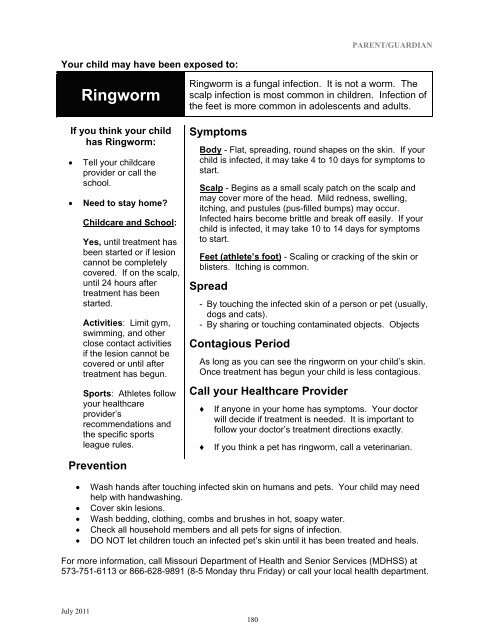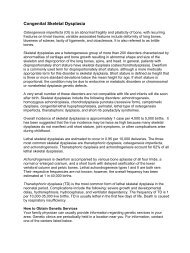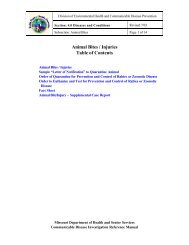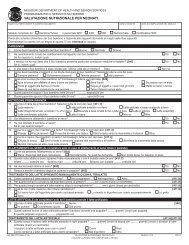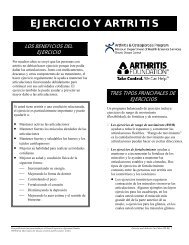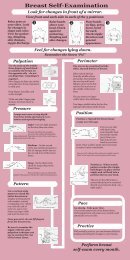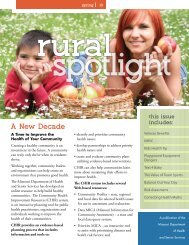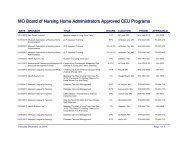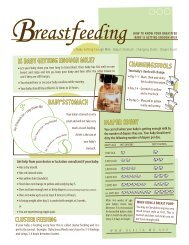Prevention and Control of Communicable Diseases - Missouri ...
Prevention and Control of Communicable Diseases - Missouri ...
Prevention and Control of Communicable Diseases - Missouri ...
You also want an ePaper? Increase the reach of your titles
YUMPU automatically turns print PDFs into web optimized ePapers that Google loves.
Your child may have been exposed to:<br />
July 2011<br />
Ringworm<br />
If you think your child<br />
has Ringworm:<br />
� Tell your childcare<br />
provider or call the<br />
school.<br />
� Need to stay home?<br />
Childcare <strong>and</strong> School:<br />
Yes, until treatment has<br />
been started or if lesion<br />
cannot be completely<br />
covered. If on the scalp,<br />
until 24 hours after<br />
treatment has been<br />
started.<br />
Activities: Limit gym,<br />
swimming, <strong>and</strong> other<br />
close contact activities<br />
if the lesion cannot be<br />
covered or until after<br />
treatment has begun.<br />
Sports: Athletes follow<br />
your healthcare<br />
provider’s<br />
recommendations <strong>and</strong><br />
the specific sports<br />
league rules.<br />
<strong>Prevention</strong><br />
180<br />
PARENT/GUARDIAN<br />
Ringworm is a fungal infection. It is not a worm. The<br />
scalp infection is most common in children. Infection <strong>of</strong><br />
the feet is more common in adolescents <strong>and</strong> adults.<br />
Symptoms<br />
Body - Flat, spreading, round shapes on the skin. If your<br />
child is infected, it may take 4 to 10 days for symptoms to<br />
start.<br />
Scalp - Begins as a small scaly patch on the scalp <strong>and</strong><br />
may cover more <strong>of</strong> the head. Mild redness, swelling,<br />
itching, <strong>and</strong> pustules (pus-filled bumps) may occur.<br />
Infected hairs become brittle <strong>and</strong> break <strong>of</strong>f easily. If your<br />
child is infected, it may take 10 to 14 days for symptoms<br />
to start.<br />
Feet (athlete’s foot) - Scaling or cracking <strong>of</strong> the skin or<br />
blisters. Itching is common.<br />
Spread<br />
- By touching the infected skin <strong>of</strong> a person or pet (usually,<br />
dogs <strong>and</strong> cats).<br />
- By sharing or touching contaminated objects. Objects<br />
Contagious Period<br />
As long as you can see the ringworm on your child’s skin.<br />
Once treatment has begun your child is less contagious.<br />
Call your Healthcare Provider<br />
♦ If anyone in your home has symptoms. Your doctor<br />
will decide if treatment is needed. It is important to<br />
follow your doctor’s treatment directions exactly.<br />
♦ If you think a pet has ringworm, call a veterinarian.<br />
� Wash h<strong>and</strong>s after touching infected skin on humans <strong>and</strong> pets. Your child may need<br />
help with h<strong>and</strong>washing.<br />
� Cover skin lesions.<br />
� Wash bedding, clothing, combs <strong>and</strong> brushes in hot, soapy water.<br />
� Check all household members <strong>and</strong> all pets for signs <strong>of</strong> infection.<br />
� DO NOT let children touch an infected pet’s skin until it has been treated <strong>and</strong> heals.<br />
For more information, call <strong>Missouri</strong> Department <strong>of</strong> Health <strong>and</strong> Senior Services (MDHSS) at<br />
573-751-6113 or 866-628-9891 (8-5 Monday thru Friday) or call your local health department.


